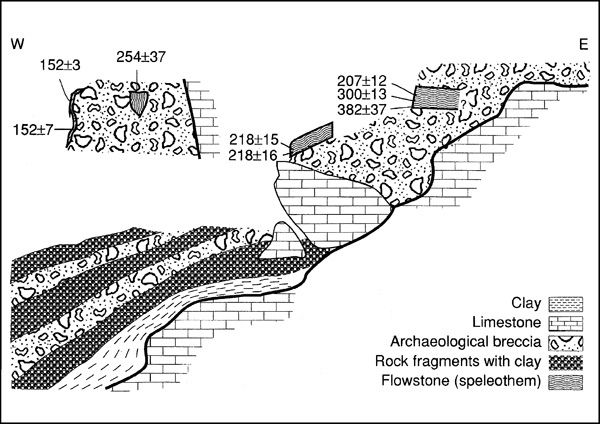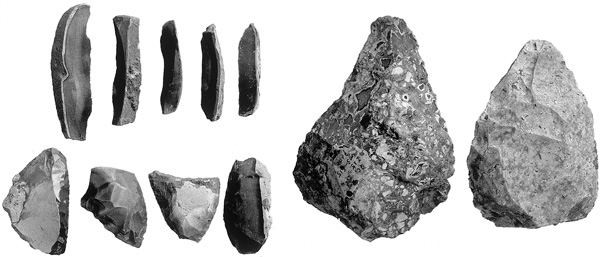Qesem Cave
INTRODUCTION
Qesem Cave is situated 12 km east of the Mediterranean coast, 90 m above sea level, in the western foothills of the Samaria Hills. The cave was formed in Turonian limestone under phreatic conditions, like other chamber caves in the area. After regional uplift it was dewatered and truncated by sub-aerial erosion. It has undergone several stages of natural and human-induced deposition, as well as subsidence and collapse. The cave was discovered in 2000 during construction work. Its ceiling is no longer extant due to natural erosion and recent construction works, and some of the cave deposits have been damaged. Enough was preserved, however, to justify the initiation of a field project.

EXCAVATION RESULTS
The 2001 salvage excavation, directed by A. Gopher and R. Barkai on behalf of Tel Aviv University and the Israel Antiquities Authority, exposed a stratigraphic sequence about 7.5 m deep that contained distinct archaeological horizons. Each horizon yielded lithic assemblages and abundant faunal remains, all attributed to the Acheulo-Yabrudian complex of the late Lower Paleolithic. The archaeological horizons showed differences in lithic technology and typology. The various lithic assemblages were found interspersed within the stratigraphic sequence, much like those in layer E at Tabun Cave and in Yabrud I. Some of the assemblages were dominated by flint blades and blade tools, while in others blades were rare or absent. Thick side-scrapers, the fossile directeur of Yabrudian industries, appeared throughout the stratigraphic sequence. Hand axes, the characteristic Lower Paleolithic tool type, appeared in small numbers both at the top and bottom of the sequence, but not in every assemblage. At the base of the cave, just above bedrock, the lithic assemblages were flake dominated, and typical Acheulo-Yabrudian tool types were rare, while chopping tools and spheroids, typical of Lower Paleolithic Acheulian industries, were found. It thus appears that there may have been human occupation at Qesem Cave pre-dating the Acheulo-Yabrudian. The abundant faunal remains from the Acheulo-Yabrudian horizons comprise mainly deer, equids, bovids, and pigs. Smaller animals, including predators, are rare.

The upper layers of Qesem Cave were dated based on speleothems from the eastern section of the cave. The 230Th/234U dates were measured by thermal ionization mass spectrometry (TIMS). A major flowstone deposition took place between 380,000 and 210,000
The dates of Qesem Cave appear to represent the end of the final cultural phase of the Lower Paleolithic—the Acheulo-Yabrudian complex—supporting a maximum age limit of c. 210,000
Very few Acheulo-Yabrudian sites are known from the southern Levant and very little research has been conducted on this entity in recent decades. The discovery of Qesem Cave, the southernmost Acheulo-Yabrudian site yet found, extends the known geographic boundaries of this complex and presents an opportunity to renew research into the Acheulo-Yabrudian complex and the transition from the Lower to the Middle Paleolithic.
AVI GOPHER, RAN BARKAI
INTRODUCTION
Qesem Cave is situated 12 km east of the Mediterranean coast, 90 m above sea level, in the western foothills of the Samaria Hills. The cave was formed in Turonian limestone under phreatic conditions, like other chamber caves in the area. After regional uplift it was dewatered and truncated by sub-aerial erosion. It has undergone several stages of natural and human-induced deposition, as well as subsidence and collapse. The cave was discovered in 2000 during construction work. Its ceiling is no longer extant due to natural erosion and recent construction works, and some of the cave deposits have been damaged. Enough was preserved, however, to justify the initiation of a field project.
